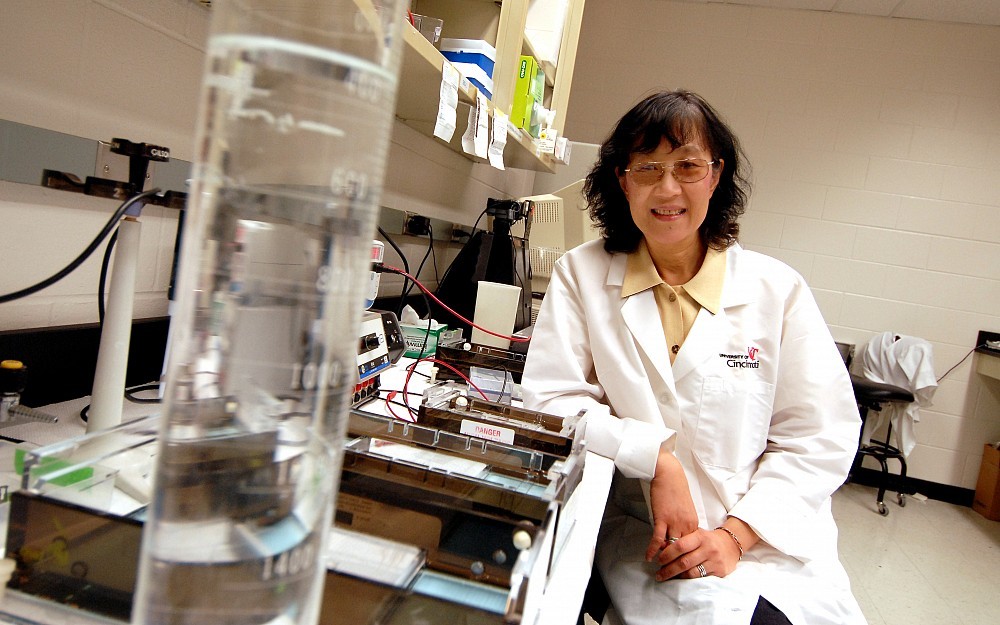
$7.8 Million Grant Supports Gene-Environment Interaction Research
CincinnatiThe University of Cincinnatis (UC) environmental health department has received a $7.8 million grant to continue operating its Center for Environmental Genetics (CEG).
Led by Shuk-mei Ho, PhD, director, CEG supports state-of-the-art core facilities and technologies needed to conduct innovative research that focuses on how environmental agents interact with genetic and epigenetic factors to influence disease risk and outcome.
This funding renewal, which comes from the National Institute of Environmental Health Sciences (NIEHS), will be dispersed in annual increments of $1.56 million through 2012. The center is one of only 16 environmental centers funded by the NIEHS and is currently in its 16th year of operation.
The CEG allows us to pool resources and invest in new technologies and investigators that enable us to expedite our findings and increase the translational aspects of our work, says Ho, Jacob G. Schmidlapp professor and chair of UCs environmental health department.
Founded by Daniel Nebert, MD, UC professor of environmental health, in 1992, the CEG encourages research collaboration between basic and applied scientists, epidemiologists, and clinicians seeking to understand the complex relationships between genetic predisposition to disease and environmental exposures.
This renewal will put special emphasis on new opportunities and emerging technologies to integrate research that follows diseases through a persons lifespan, says Bruce Lanphear, MD, who is a professor of environmental health and pediatrics. This grant will enable researchers at UC and Cincinnati Childrens Hospital Medical Center to conduct state-of-the-art environmental research across both campuses.
Although the specific research subject varies greatly by researcher, were all trying to answer one overriding question: Why do people exposed to the same dose of environmental toxicant have different levels of disease? says Nebert, professor of environmental health.
Were striving to improve human health through multidisciplinary approaches that bring together basic research, clinical practice and public health initiatives that prevent illness and decrease mortality from diseases associated with environmental exposures, adds Alvaro Puga, PhD, professor of environmental health.
Puga serves as deputy director of the CEG. Nebert and Lanphear are associate directors.
The center has nearly 150 members, including established and new basic, translational and clinical investigators from the UC College of Medicine and Cincinnati Childrens. Members have access to collaborative resources in three service cores:
· Bioinformatics core, led by Mario Medvedovic, PhD, and Jarek Meller, PhD, associate professors of environmental health, help researchers collect and organize data on how proteins function in the body and understand how that information might translate into new targets for drug development. The team also helps researchers design and analyze gene-expression experiments, and understand the biological implications of results.
· Integrative technologies core, led by Ho, offers specialized services and expert consultation in facilities such as genome and microarray, transgenic mouse construction, microscopy, genotyping, proteomics and metabonomics, high-field magnetic resonance imaging and spectroscopy, flow cytometry and mass spectrometry.
· Integrative health sciences core, led by Susan Pinney, PhD, associate professor of environmental health, and Peter Embi, MD, assistant professor of medicine guide CEG members through designing epidemiologic research studies, clinical trials and clinical databases as well as biospecimen acquisition.
In addition to supporting shared research services, the CEG annually awards about $200,000 in pilot research grants to support research initiatives from established environmental health researchers, attract new investigators to the field and enable collaborative research that focuses on population- or patient-based studies.
The traditional funding system doesnt always encourage creativity. Pilot grants allow us to support promising ideas that may have never qualified for funding from traditional sources, says Ho, who is well-known for her work in epigenetics, a novel field that she advanced thanks to pilot funding from NIEHS and the U.S. Department of Defense.
In the past five years, the CEG has provided $1 million in pilot grants and helped generate nearly $18 million in funding support.
The CEG also incorporates a career development program, directed by Grace LeMasters, PhD, professor of environmental health and Daniel Woo, MD, associate professor of neurosurgery. The effort focuses on developing the next generation of environmental health science researchers to conduct transdisciplinary research, and encourage use of modern technologies in environmental health sciences.
UCs environmental health department is ranked fourth among National Institutes of Health-funded environmental health research programs. The department holds more than 140 grants and research contracts totaling more than $24 million in direct funding annually.
For more information, visit www.eh.uc.edu.
Related Stories
Ancient Maya blessed their ballcourts
April 26, 2024
Using environmental DNA analysis, researchers identified a collection of plants used in ceremonial rituals in the ancient Maya city of Yaxnohcah. The plants, known for their religious associations and medicinal properties, were discovered beneath a plaza floor upon which a ballcourt was built, suggesting the building might have been blessed or consecrated during construction.
OTR mural centerpiece of 'big' celebration of UC alumni
April 26, 2024
New downtown artwork salutes 18 alumni award recipients who personify UC’s alumni success.
2024 Daniel Drake Medals to be awarded April 27
April 24, 2024
The UC College of Medicine will award three people with 2024 Daniel Drake Medals April 27.
